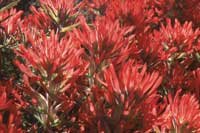 When I worked at Arches National Park, I was fortunate to witness the floral progression of spring wildflowers season after season. I came to expect certain species in particular locations each year, but during dry years it took more search effort to find those wildflowers. Now, twenty-five years later, I can still envision the Eaton’s penstemon anchored in the slickrock along the entrance road switchbacks, the fragrant shrubs of cliffrose near Park Avenue, the spectacle pod along the Great Wall, the mules-ears past Balanced Rock, the sego lilies near Cache Valley, and the abundant yellow beeplant in Salt Valley. Many blooms, many fond memories.
When I worked at Arches National Park, I was fortunate to witness the floral progression of spring wildflowers season after season. I came to expect certain species in particular locations each year, but during dry years it took more search effort to find those wildflowers. Now, twenty-five years later, I can still envision the Eaton’s penstemon anchored in the slickrock along the entrance road switchbacks, the fragrant shrubs of cliffrose near Park Avenue, the spectacle pod along the Great Wall, the mules-ears past Balanced Rock, the sego lilies near Cache Valley, and the abundant yellow beeplant in Salt Valley. Many blooms, many fond memories.
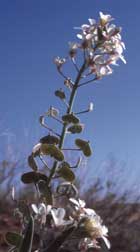 Though I knew where certain species bloomed throughout the park, my favorite area to botanize was along the Cache Valley road and area around Delicate Arch. A variety of geologic formations in the area made for great wildflower hunting in May.
Though I knew where certain species bloomed throughout the park, my favorite area to botanize was along the Cache Valley road and area around Delicate Arch. A variety of geologic formations in the area made for great wildflower hunting in May.
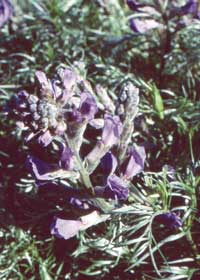 Starting at the Delicate Arch road turnoff, a small patch of narrow-leaf sophora would indicate this turn. The fine silvery foliage and bluish-purple, pea-shaped flowers made this plant stand out. Though toxic to livestock, this plant found a home in the park.
Starting at the Delicate Arch road turnoff, a small patch of narrow-leaf sophora would indicate this turn. The fine silvery foliage and bluish-purple, pea-shaped flowers made this plant stand out. Though toxic to livestock, this plant found a home in the park.
Nearby, on outcrops of the grayish Mancos Shale, large numbers of yellow milkvetch, in the Pea family, would blanket the desert. Sometimes a hike up nearby Two Juniper Butte would yield other members of this family such as sweetvetch and locoweed.
Farther down the road near the crossing of Salt Valley Wash, the alkaline soils would bear shrubs such as shadscale, saltbush and greasewood. Not known for their floral displays – the flowers are easily overlooked – these plants represented those hardy desert shrubs that could survive salty soils and alkaline water. Important browse plants, these members of the Goosefoot family provide seeds and shade to a variety of small creatures such as sparrows, jackrabbits and white-tailed antelope ground squirrels.
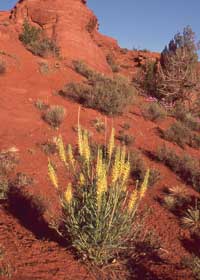 At the end of the road, the flats of Mancos Shale or outcrops of Dakota Sandstone could host vast quantities of sego lilies, desert trumpets and prince’s plumes. The lilies, representing the Utah State Flower, would show dainty petals fringed on the inside, while the prince’s plumes produced long spikes of yellow flowers. The desert trumpets’ flowers were tiny and non-descript, but the plant’s inflated stems made their identification easy.
At the end of the road, the flats of Mancos Shale or outcrops of Dakota Sandstone could host vast quantities of sego lilies, desert trumpets and prince’s plumes. The lilies, representing the Utah State Flower, would show dainty petals fringed on the inside, while the prince’s plumes produced long spikes of yellow flowers. The desert trumpets’ flowers were tiny and non-descript, but the plant’s inflated stems made their identification easy.
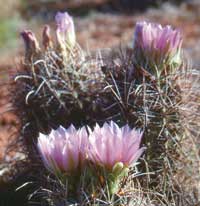 On the hiking trail to Delicate Arch, dwarf evening primrose, Whipple’s fishhook, and Indian paintbrush would entertain hikers with splashes of color. The evening primroses would bloom at night and fade during the day, their striking flowers attracting nocturnal pollinators such as sphinx moths. The day-blooming purplish flowers of the fishhook cactus would be somewhat protected by the fishhook-shaped spines, but still attract a variety of insect pollinators.
On the hiking trail to Delicate Arch, dwarf evening primrose, Whipple’s fishhook, and Indian paintbrush would entertain hikers with splashes of color. The evening primroses would bloom at night and fade during the day, their striking flowers attracting nocturnal pollinators such as sphinx moths. The day-blooming purplish flowers of the fishhook cactus would be somewhat protected by the fishhook-shaped spines, but still attract a variety of insect pollinators.
After a visit to Delicate Arch, I would descend to the trailhead via the seep line that marked the edge of the trail. Here I would find moisture-loving plants such as alcove columbine, Easter flower, scarlet monkeyflower and death camas, named for its toxic bulbs.
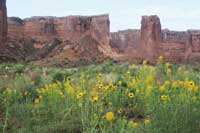 I liked to think that checking out these plants and wildflowers was part of my ranger job: to know what was blooming where and when, and report back. I know it was rough duty, but someone had to do it, to take part in this spring floral parade. I felt fortunate to be the one to go.
I liked to think that checking out these plants and wildflowers was part of my ranger job: to know what was blooming where and when, and report back. I know it was rough duty, but someone had to do it, to take part in this spring floral parade. I felt fortunate to be the one to go.